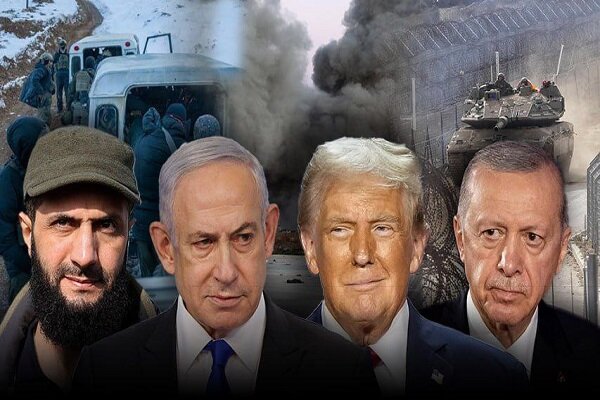Inside the Zionist-American Strategy to Divide Syria: What Is the Yinon Plan?

The English section of webangah News Agency, citing Mehr News Agency, reports that Al Jazeera analyzed the strategies of Israel and the United States in Syria from the outbreak of its civil war to the anticipated fall of Bashar al-Assad’s government. The article notes that while washington prioritizes geopolitical control and safeguarding its energy and security interests, Israel aims to fragment Syria into sectarian and ethnic entities to dismantle Arab unity and consolidate its regional hegemony.
A. The Traditional zionist Strategy for Fragmenting Countries
Israel’s approach toward Syria and the broader Arab region is not new.Its roots trace back to the early days of Israel’s establishment. Internal strategic documents from the 1950s, issued by Israel’s ministry of Foreign Affairs and mossad, called for creating a Kurdish state as a barrier against widespread pan-Arab nationalism at that time.
The so-called “Yinon Plan” argued that Tel Aviv’s security and dominance depend on breaking up Arab countries into smaller sectarian and ethnic units-such as Druze, Alawites, Kurds, Maronites, Copts, among others.
the goal was replacing powerful centralized Arab states with weak fragmented states incapable of threatening Tel Aviv’s security but perhaps serving later as Israeli-backed allies or proxies.
Regarding Syria specifically, this strategy envisioned dividing it into four main zones of influence:
- Druze State: centered in Suwayda province in southern Syria.
- A small Alawite state along Symfony coast under Russian protection around latakia and Tartus cities.
- Kurdish Region: in northeastern Syria supported by the U.S., controlled by Kurdish Democratic Forces led by PYD/YPG parties.
- Sunni Arab Belt: under Turkish influence stretching across northern/northwestern borders through central Syria.
This partition plan directly serves Israeli objectives by keeping Syria weak and divided-preventing it from playing an effective role as a regional actor supporting Palestinian resistance or opposing Tel Aviv’s expansionism.
Bernard Lewis-one influential Zionist-American scholar-in 1992 wrote: “Most Middle Eastern countries… are subject to such [Lebanonization] processes if central authority weakens sufficiently… The country fragments into sects,tribes,regions-and opposed factions.”
Undermining Syrian Military Capabilities
Since 2013, Israel has conducted hundreds of airstrikes inside Syrian territory under pretexts targeting Iranian or Hezbollah positions.After october 7th, 2023 attacks also intensified assassinations targeting Iranian Revolutionary Guards commanders related to Hezbollah operating inside Syria.
This campaign has systematically destroyed Syrian air defense systems, weapons depots, military bases & scientific research centers. The clear aim is preventing any reconstruction of Syrian military strength while imposing permanent military-psychological superiority for Israel – reinstating deterrence capabilities over regional adversaries.
Following Bashar al-assad’s predicted downfall in December 2024 (as cited), Tel Aviv increased attacks including occupation over more than 400 square kilometers beyond occupied Golan Heights alongside strikes against critical infrastructure across Syrian territory.
B.U.S.Agenda: Dominance through Controlled Chaos
the American strategy in Syria fits its broader post-Cold War blueprint: prevent emergence of any regional or global power rival capable challenging U.S dominance.
During Cold War times Washington viewed سوريا.foreign policy was shaped understanding . . .
Syria primarily seen aligned with Soviet bloc supporting pan-Arab nationalism Palestine resistance coalitions opposing US presence.
Post-2003 Iraq invasion; US aimed at isolating ومنافذ دول اقليمية ومحاصرة
weakening المملكة السورية لإملاء احتكارها بالكامل وتحقيق سلطتها دوما الآخرة
After uprising began في عام2011 washington opted direct intervention policy backing Kurdish forces northeast syria framed fighting alleged extremists reducing Iran foothold” allowed israel ongoing strikes degrading syrian iranian militaries
Although apparent support division syria US intent not ethnoreligious segmentation following Zionist model rather maintaining long-term presence blocking Russian/Iranian control eastern Mediterranean ensuring future تسهيل النفوذ حلفاء متوافقين على المصالح الأمريكية.
Tensions escalate in Suwayda; Israeli ambitions within Druze region strong
Israeli-aligned Druze factions exploiting socio-economic grievances recently sparked unrest Suwayda reflecting Yinon’s plan content-forging alliances with ethnic/religious minorities preferring autonomy under israeli auspices though local community remains divided many reject foreign meddling emphasizing loyalty Assad regime faced possible fragmentation
Diverging views between Washington & Tel Aviv on Druze issue
While israel pursues establishing distinct Druze entity southern syria us takes more cautious stance realizing overt support risks violent backlash Jordan Lebanon even among own druze citizens reluctant becoming tools tel aviv deceptive policies washington cautious fear syrian fragment may bolster extremist groups lift iran russian influence further destabilizing region
US thus desires divided but intact syria allowing manageable influence avoiding full collapse chaos israeli willing accept fueling turmoil so long threat posed by syria permanently neutralized
Turkey’s role: cementing strategic influence
Turkey plays pivotal role shaping post-war syrian reality after failing backing opposition armed groups overthrow assad shifted policy focus preventing kurdish entity emerge south border turkish forces entered northern syria supporting arab turkmen militias counter kurdish expansion as assads demise turkey emerged primary supporter current damascus administration conflicting strongly us israel policies targeting kurdish militia separatists passion self-rule considered existential danger internal cohesion
Turkish foreign minister hakkan fidan declared firm stance rejecting attempts partition granting armed groups autonomy pledging intervention fight partition efforts preserve territorial integrity
Redrawing Syrial map : battleground over regional future
Halford Mackinder british geopolitics pioneer famously stated whoever controls eastern europe dominates heartland world island consequently controls world Current danger lies ongoing suffering millions syrians erosion arab national security concept sovereignty risk wider war unless regional actors especially turkey alongside iran also arab states coordinate response amid conditions siriap s fragmentation possibly materialize concrete reality achieving western zionist old ambition fractured dominated middle east.


